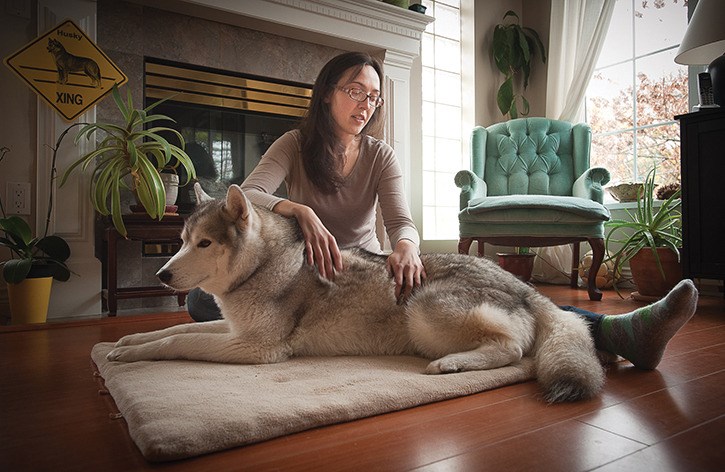The eyes may be the windows to the soul, but words are what pull back the curtains. Animals can telegraph anxiety and suffering through expressions and body language, but they have no means of explaining the source.
Thats where Marta Banat comes in.
After discovering her rescue dog, Rocco, had severe allergies and idiopathic epilepsy, she decided to undergo training at the NorthWest School of Animal Massage. She was so inspired by the results of her holistic approach, that she started All Paws Animal Massage, which brings mobile animal massage and Reiki services straight to your pet.
In careful collaboration with veterinarians, she can help your dog or cat fend off the effects of aging, relax aching muscles, and overcome fears, traumas and anxieties.
We caught up with her after a walk with Rocco to learn more:
Q:In addition to massage, what else do you do for Rocco?
A: I take him to a holistic vet, Dr. Michael Goldberg at Vancouver Animal Wellness Hospital, and Rocco gets homeopathic treatments, chiropractic adjustments. Hes always under veterinary care, but we also do massage and Reiki with him. I try to make sure its a well-balanced gentle treatment.
Q: What changes did you see in Rocco after you started massage sessions?
A: Two years ago, he would have seizures once a month. And I said, bottom line, if he has one more than every three weeks, hes going on all the drugs. But in the meantime, I thought, Lets give it a shot. Lets see what else we can do for him. So thats when we actually went to Dr. Goldberg.

Q: Do animals enjoy massage the same way humans do?
A: Its very different. Because with a human, you go in and the therapist asks what you need help with. With an animal, unless a vet says specifically what the diagnosis is and what they would like you to work on, you have to watch the animal and see where the possible tension and pain is. Its a joint effort between the vet, the owner and the practitioner to figure out what the animal needs and establish a program for them.
Q: Are your programs typically ongoing?
A: Its all about relaxing the muscles, working on tension, improving the blood flow. With senior animals, its an ongoing health program. With younger animals, its a proactive maintenance approach. Youre trying to prevent. When you have tension in your muscles, that impacts your joints, impacts your movement and you start compensating. Things build up, and when you get older, thats when you really see the effects. Or its a rehab program due to an injury we work on that, and then thats the end of it.
Q: What are signs that your animal is suffering from tension?
A: There are a few things to look out for. If you see any lameness or a different pattern of movement. One of the big things is the way they carry their head if, all of a sudden, they carry their head really low, its a sign that theres something not quite right. Always check with the vet to make sure theres no serious, underlying problems, and then decide from there what is the appropriate course of action. Another sure sign is skin twitching. When you pet your dog or cat, and you see the skin twitch, that means that the facia underneath has some adhesion or theres tension.
Q: When did you realize this was what you wanted to do?
A: I worked so much with my dog when I was learning techniques and studying, seeing firsthand the day-to-day benefits. And then I had a client a cat who had a traumatic event and was afraid of the ceiling fan and wouldnt go to her litter box. So we did a relaxation session and Reiki, and it really worked for that fear.
Q: Are referrals required?
A: If there is a case such as injury or lameness, that comes through the vet. But one of my passions is working with anxiety and fear, and massage is an amazing way to teach an animal to relax. In cases of abuse or anxiety, the body might not know how to turn that off and achieve relaxation. So I use a scent or music or a specific bed, and then I ask the owner to turn on that trigger or bring out that bed [at home] and the brain has the cue. The more often you do it, you teach the brain and the body to go into the relaxation state.
Q: Are the techniques similar to human massage?
A: We dont do deep tissue massage unless this is something the vet wants us to do. We do very gentle strokes, but its all based on Swedish massage techniques. In reality, you gain more with less. Gentle techniques are where you get the most results; especially with arthritic dogs and painful cases. Youre going to do gentle strokes that create release and fluid flow, or create or dissipate heat.
Q: How do the animals respond initially?
A: Its such an individual thing. Usually the first session, theres very little actual massage happening because I introduce a touch that is very unusual to them. This is not just petting. Im touching specific sites and Im doing it in a very specific way. But because, usually, this results in a feeling of relief or ease or pleasure, then by the second session, they go, You know what? I felt so much better afterward, Im just going to plop myself right here and you can do your thing.



